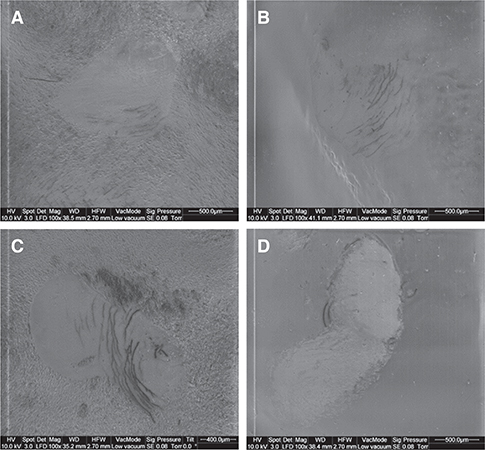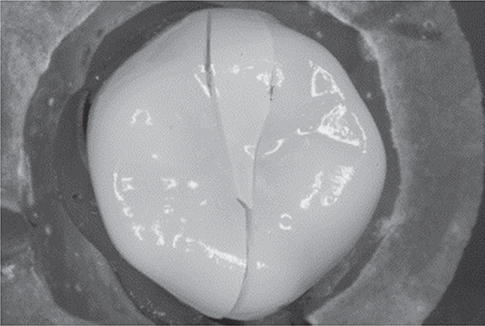J Adv Prosthodont.
2018 Aug;10(4):300-307. 10.4047/jap.2018.10.4.300.
In vitro performance and fracture resistance of novel CAD/CAM ceramic molar crowns loaded on implants and human teeth
- Affiliations
-
- 1Department of Prosthetic Dentistry, UKR University Hospital Regensburg, Regensburg, Germany. verena.preis@ukr.de
- KMID: 2418636
- DOI: http://doi.org/10.4047/jap.2018.10.4.300
Abstract
- PURPOSE
To investigate the fatigue and fracture resistance of computer-aided design and computer-aided manufacturing (CAD/CAM) ceramic molar crowns on dental implants and human teeth.
MATERIALS AND METHODS
Molar crowns (n=48; n=8/group) were fabricated of a lithium-disilicate-strengthened lithium aluminosilicate glass ceramic (N). Surfaces were polished (P) or glazed (G). Crowns were tested on human teeth (T) and implant-abutment analogues (I) simulating a chairside (C, crown bonded to abutment) or labside (L, screw channel) procedure for implant groups. Polished/glazed lithium disilicate (E) crowns (n=16) served as reference. Combined thermal cycling and mechanical loading (TC: 3000×5℃/3000×55℃; ML: 1.2×106 cycles, 50 N) with antagonistic human molars (groups T) and steatite spheres (groups I) was performed under a chewing simulator. TCML crowns were then analyzed for failures (optical microscopy, SEM) and fracture force was determined. Data were statistically analyzed (Kolmogorow-Smirnov, one-way-ANOVA, post-hoc Bonferroni, α=.05).
RESULTS
All crowns survived TCML and showed small traces of wear. In human teeth groups, fracture forces of N crowns varied between 1214±293 N (NPT) and 1324±498 N (NGT), differing significantly (P≤.003) from the polished reference EPT (2044±302 N). Fracture forces in implant groups varied between 934±154 N (NGI_L) and 1782±153 N (NPI_C), providing higher values for the respective chairside crowns. Differences between polishing and glazing were not significant (P≥.066) between crowns of identical materials and abutment support.
CONCLUSION
Fracture resistance was influenced by the ceramic material, and partly by the tooth or implant situation and the clinical procedure (chairside/labside). Type of surface finish (polishing/glazing) had no significant influence. Clinical survival of the new glass ceramic may be comparable to lithium disilicate.
MeSH Terms
Figure
Reference
-
1. Rauch A, Reich S, Schierz O. Chair-side generated posterior monolithic lithium disilicate crowns: clinical survival after 6 years. Clin Oral Investig. 2017; 21:2083–2089.2. Gehrt M, Wolfart S, Rafai N, Reich S, Edelhoff D. Clinical results of lithium-disilicate crowns after up to 9 years of service. Clin Oral Investig. 2013; 17:275–284.
Article3. Toman M, Toksavul S. Clinical evaluation of 121 lithium disilicate all-ceramic crowns up to 9 years. Quintessence Int. 2015; 46:189–197.4. Pieger S, Salman A, Bidra AS. Clinical outcomes of lithium disilicate single crowns and partial fixed dental prostheses: a systematic review. J Prosthet Dent. 2014; 112:22–30.
Article5. Cacaci C, Cantner F, Mücke T, Randelzhofer P, Hajtó J, Beuer F. Clinical performance of screw-retained and cemented implant-supported zirconia single crowns: 36-month results. Clin Oral Investig. 2017; 21:1953–1959.
Article6. Dogan S, Raigrodski AJ, Zhang H, Mancl LA. Prospective cohort clinical study assessing the 5-year survival and success of anterior maxillary zirconia-based crowns with customized zirconia copings. J Prosthet Dent. 2017; 117:226–232.
Article7. Nejatidanesh F, Moradpoor H, Savabi O. Clinical outcomes of zirconia-based implant- and tooth-supported single crowns. Clin Oral Investig. 2016; 20:169–178.
Article8. Wasiluk G, Chomik E, Gehrke P, Pietruska M, Skurska A, Pietruski J. Incidence of undetected cement on CAD/CAM monolithic zirconia crowns and customized CAD/CAM implant abutments. A prospective case series. Clin Oral Implants Res. 2017; 28:774–778.
Article9. Preis V, Hahnel S, Behr M, Bein L, Rosentritt M. In-vitro fatigue and fracture testing of CAD/CAM-materials in implant-supported molar crowns. Dent Mater. 2017; 33:427–433.
Article10. Rosentritt M, Raab P, Hahnel S, Stöckle M, Preis V. In-vitro performance of CAD/CAM-fabricated implant-supported temporary crowns. Clin Oral Investig. 2017; 21:2581–2587.
Article11. Rosentritt M, Hahnel S, Engelhardt F, Behr M, Preis V. In vitro performance and fracture resistance of CAD/CAM-fabricated implant supported molar crowns. Clin Oral Investig. 2017; 21:1213–1219.
Article12. Zarone F, Sorrentino R, Traini T, Di lorio D, Caputi S. Fracture resistance of implant-supported screw- versus cement-retained porcelain fused to metal single crowns: SEM fractographic analysis. Dent Mater. 2007; 23:296–301.
Article13. Al-Omari WM, Shadid R, Abu-Naba'a L, El Masoud B. Porcelain fracture resistance of screw-retained, cement-retained, and screw-cement-retained implant-supported metal ceramic posterior crowns. J Prosthodont. 2010; 19:263–273.
Article14. Pjetursson BE, Thoma D, Jung R, Zwahlen M, Zembic A. A systematic review of the survival and complication rates of implant-supported fixed dental prostheses (FDPs) after a mean observation period of at least 5 years. Clin Oral Implants Res. 2012; 23:Suppl 6. 22–38.15. Romeo E, Lops D, Margutti E, Ghisolfi M, Chiapasco M, Vogel G. Long-term survival and success of oral implants in the treatment of full and partial arches: a 7-year prospective study with the ITI dental implant system. Int J Oral Maxillofac Implants. 2004; 19:247–259.16. Jung RE, Pjetursson BE, Glauser R, Zembic A, Zwahlen M, Lang NP. A systematic review of the 5-year survival and complication rates of implant-supported single crowns. Clin Oral Implants Res. 2008; 19:119–130.
Article17. Zimmermann M, Koller C, Mehl A, Hickel R. Indirect zirconia-reinforced lithium silicate ceramic CAD/CAM restorations: Preliminary clinical results after 12 months. Quintessence Int. 2017; 48:19–25.18. Dirxen C, Blunck U, Preissner S. Clinical performance of a new biomimetic double network material. Open Dent J. 2013; 7:118–122.
Article19. Preis V, Behr M, Hahnel S, Rosentritt M. Influence of cementation on in vitro performance, marginal adaptation and fracture resistance of CAD/CAM-fabricated ZLS molar crowns. Dent Mater. 2015; 31:1363–1369.
Article20. Schwindling FS, Rues S, Schmitter M. Fracture resistance of glazed, full-contour ZLS incisor crowns. J Prosthodont Res. 2017; 61:344–349.
Article21. Belli R, Wendler M, de Ligny D, Cicconi MR, Petschelt A, Peterlik H, Lohbauer U. Chairside CAD/CAM materials. Part 1: Measurement of elastic constants and microstructural characterization. Dent Mater. 2017; 33:84–98.
Article22. Wendler M, Belli R, Petschelt A, Mevec D, Harrer W, Lube T, Danzer R, Lohbauer U. Chairside CAD/CAM materials. Part 2: Flexural strength testing. Dent Mater. 2017; 33:99–109.
Article23. Ramos Nde C, Campos TM, Paz IS, Machado JP, Bottino MA, Cesar PF, Melo RM. Microstructure characterization and SCG of newly engineered dental ceramics. Dent Mater. 2016; 32:870–878.24. Scharnagl P, Behr M, Rosentritt M, Leibrock A, Handel G. Simulation of physiological tooth mobility in in-vitro stress examination of dental restorations in the masticator. J Dent Res. 1998; 77:1260. Abstract 431.25. Rosentritt M, Behr M, Gebhard R, Handel G. Influence of stress simulation parameters on the fracture strength of all-ceramic fixed-partial dentures. Dent Mater. 2006; 22:176–182.
Article26. Rosentritt M, Behr M, Scharnagl P, Handel G, Kolbeck C. Influence of resilient support of abutment teeth on fracture resistance of all-ceramic fixed partial dentures: an in vitro study. Int J Prosthodont. 2011; 24:465–468.27. Rosentritt M, Behr M, van der Zel JM, Feilzer AJ. Approach for valuating the influence of laboratory simulation. Dent Mater. 2009; 25:348–352.
Article28. Rosentritt M, Siavikis G, Behr M, Kolbeck C, Handel G. Approach for valuating the significance of laboratory simulation. J Dent. 2008; 36:1048–1053.
Article29. Fasbinder DJ, Dennison JB, Heys D, Neiva G. A clinical evaluation of chairside lithium disilicate CAD/CAM crowns: a two-year report. J Am Dent Assoc. 2010; 141:10S–14S.30. Reich S, Schierz O. Chair-side generated posterior lithium disilicate crowns after 4 years. Clin Oral Investig. 2013; 17:1765–1772.31. Yang R, Arola D, Han Z, Zhang X. A comparison of the fracture resistance of three machinable ceramics after thermal and mechanical fatigue. J Prosthet Dent. 2014; 112:878–885.
Article32. Zesewitz TF, Knauber AW, Nothdurft FP. Fracture resistance of a selection of full-contour all-ceramic crowns: an in vitro study. Int J Prosthodont. 2014; 27:264–266.
Article33. Carvalho AO, Bruzi G, Giannini M, Magne P. Fatigue resistance of CAD/CAM complete crowns with a simplified cementation process. J Prosthet Dent. 2014; 111:310–317.
Article34. Seydler B, Rues S, Müller D, Schmitter M. In vitro fracture load of monolithic lithium disilicate ceramic molar crowns with different wall thicknesses. Clin Oral Investig. 2014; 18:1165–1171.
Article35. Varga S, Spalj S, Lapter Varga M, Anic Milosevic S, Mestrovic S, Slaj M. Maximum voluntary molar bite force in subjects with normal occlusion. Eur J Orthod. 2011; 33:427–433.
Article36. Chavali R, Nejat AH, Lawson NC. Machinability of CAD-CAM materials. J Prosthet Dent. 2017; 118:194–199.
Article37. Weyhrauch M, Igiel C, Scheller H, Weibrich G, Lehmann KM. Fracture strength of monolithic all-ceramic crowns on titanium implant abutments. Int J Oral Maxillofac Implants. 2016; 31:304–309.
Article38. Salazar Marocho SM, Studart AR, Bottino MA, Bona AD. Mechanical strength and subcritical crack growth under wet cyclic loading of glass-infiltrated dental ceramics. Dent Mater. 2010; 26:483–490.
Article39. Mair LH, Stolarski TA, Vowles RW, Lloyd CH. Wear: mechanisms, manifestations and measurement. Report of a workshop. J Dent. 1996; 24:141–148.
Article40. Kim JW, Kim JH, Thompson VP, Zhang Y. Sliding contact fatigue damage in layered ceramic structures. J Dent Res. 2007; 86:1046–1050.
Article41. Preis V, Behr M, Handel G, Schneider-Feyrer S, Hahnel S, Rosentritt M. Wear performance of dental ceramics after grinding and polishing treatments. J Mech Behav Biomed Mater. 2012; 10:13–22.
Article42. Aurélio IL, Dorneles LS, May LG. Extended glaze firing on ceramics for hard machining: Crack healing, residual stresses, optical and microstructural aspects. Dent Mater. 2017; 33:226–240.
Article43. Preis V, Grumser K, Schneider-Feyrer S, Behr M, Rosentritt M. Cycle-dependent in vitro wear performance of dental ceramics after clinical surface treatments. J Mech Behav Biomed Mater. 2016; 53:49–58.
Article44. Hussien AN, Rayyan MM, Sayed NM, Segaan LG, Goodacre CJ, Kattadiyil MT. Effect of screw-access channels on the fracture resistance of 3 types of ceramic implant-supported crowns. J Prosthet Dent. 2016; 116:214–220.
Article45. Rosentritt M, Hagemann A, Hahnel S, Behr M, Preis V. In vitro performance of zirconia and titanium implant/abutment systems for anterior application. J Dent. 2014; 42:1019–1026.
Article46. Preis V, Kammermeier A, Handel G, Rosentritt M. In vitro performance of two-piece zirconia implant systems for anterior application. Dent Mater. 2016; 32:765–774.
Article47. de Kok P, Kleverlaan CJ, de Jager N, Kuijs R, Feilzer AJ. Mechanical performance of implant-supported posterior crowns. J Prosthet Dent. 2015; 114:59–66.
Article48. Pjetursson BE, Karoussis I, Bürgin W, Brägger U, Lang NP. Patients' satisfaction following implant therapy. A 10-year prospective cohort study. Clin Oral Implants Res. 2005; 16:185–193.
Article49. Kammermeier A, Rosentritt M, Behr M, Schneider-Feyrer S, Preis V. In vitro performance of one- and two-piece zirconia implant systems for anterior application. J Dent. 2016; 53:94–101.
Article50. Ferrario VF, Sforza C, Zanotti G, Tartaglia GM. Maximal bite forces in healthy young adults as predicted by surface electromyography. J Dent. 2004; 32:451–457.
Article
- Full Text Links
- Actions
-
Cited
- CITED
-
- Close
- Share
- Similar articles
-
- Marginal fit of the digident CAD/CAM zirconia ceramic crowns
- Comparative fracture strength analysis of Lava and Digident CAD/CAM zirconia ceramic crowns
- In vitro evaluation of fracture strength of zirconia restoration veneered with various ceramic materials
- Six-year clinical performance of lithium disilicate glass-ceramic CAD-CAM versus metal-ceramic crowns
- Fracture resistance of CAD-CAM all-ceramic surveyed crowns with different occlusal rest seat designs



